Do it once, Do it right.
Dr. Robert Kotler has performed hundreds of ethnic rhinoplasties in Beverly Hills, Los Angeles. With 40+ years performing ethnic nose surgeries, he is considered to be one of the most experienced nose surgeons in the world. Practicing ethnic rhinoplasty in the greater Los Angeles area offers the opportunity to serve the most diverse populations in our country.
The great rhinoplasty surgeons have always recognized that the nose must fit the face. It must appear natural, as if you were born with it. The surgeon’s strongest compliment is when the patient is told, “I would have never guessed you had a nose job.”
For ethnic patients, the burden is heavier: to create a meaningful and satisfactory change but without so much alteration in key features that the surgeon’s work is at variance with the other facial features. An anatomical mismatch that has failed to deliver a natural nose consistent with one’s ethnicity is unfortunate – but avoidable. A failed ethnic rhinoplasty almost always is an operation where “too much was done.”
With Dr. Robert Kotler, your nose is in the safest hands in the country and your ethnic rhinoplasty results will be natural. He is considered a superspecialist in nose surgery (including ethnic rhinoplasty) and has the proven experience in delivering natural noses to our various patients of diverse ethnicities.
Before & After Photos for Ethnic Rhinoplasty
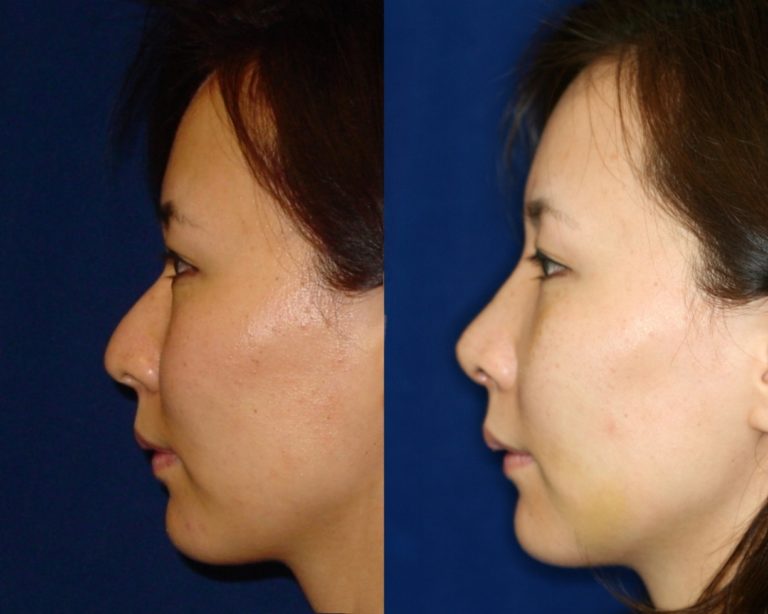
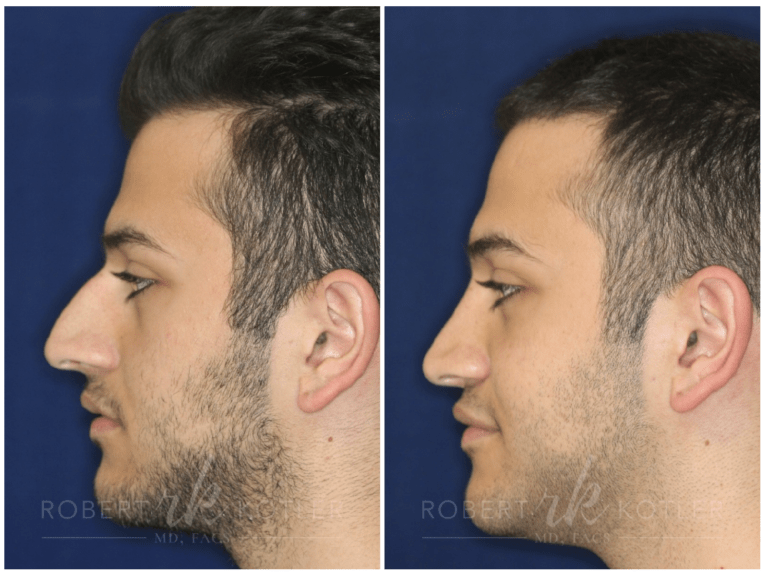
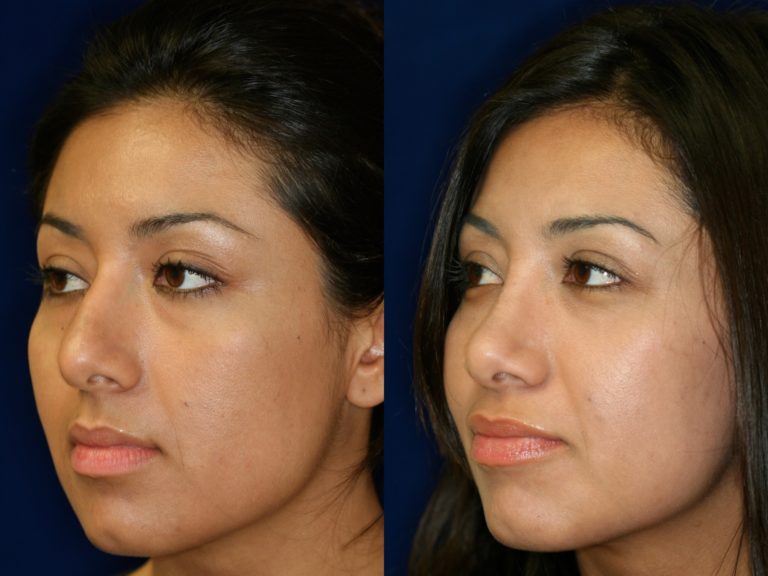
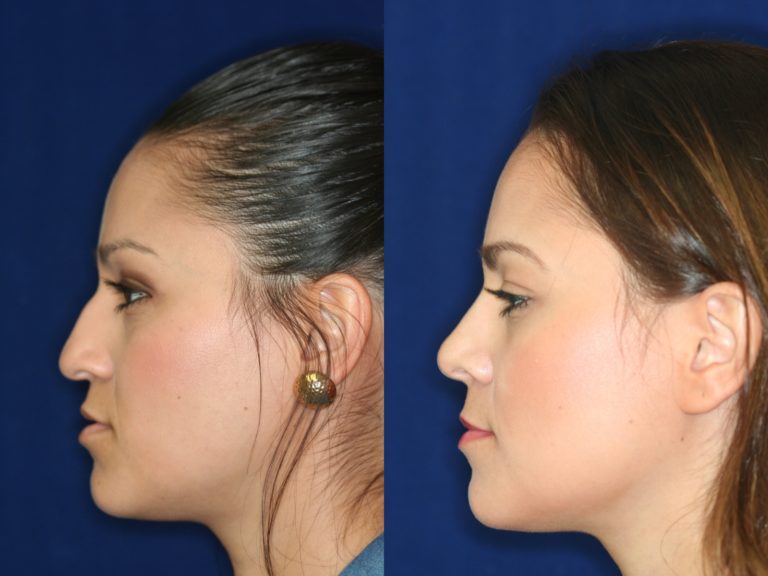
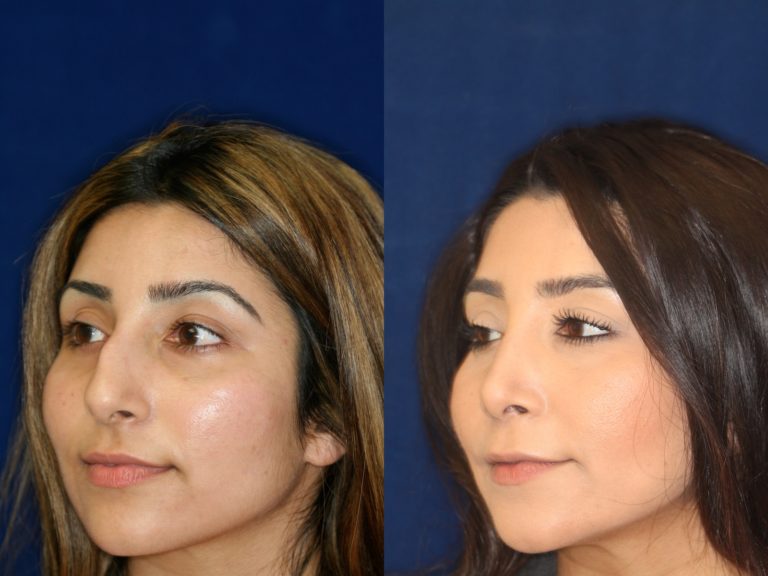
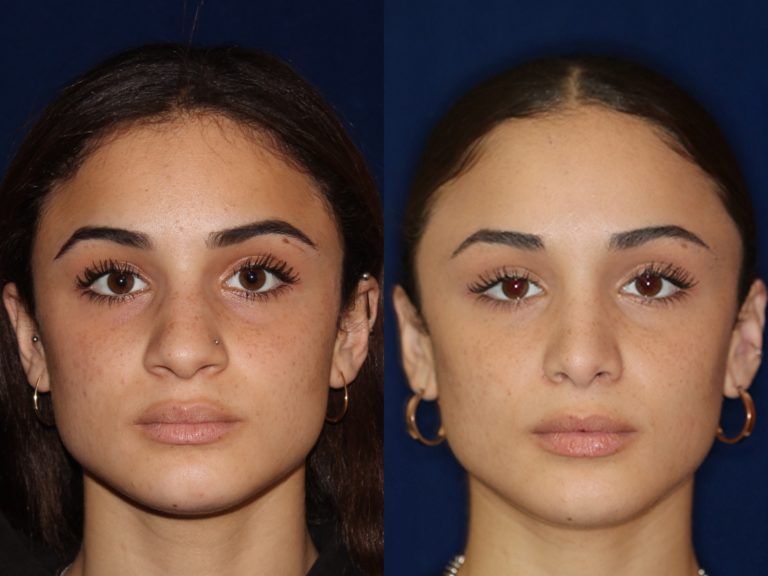
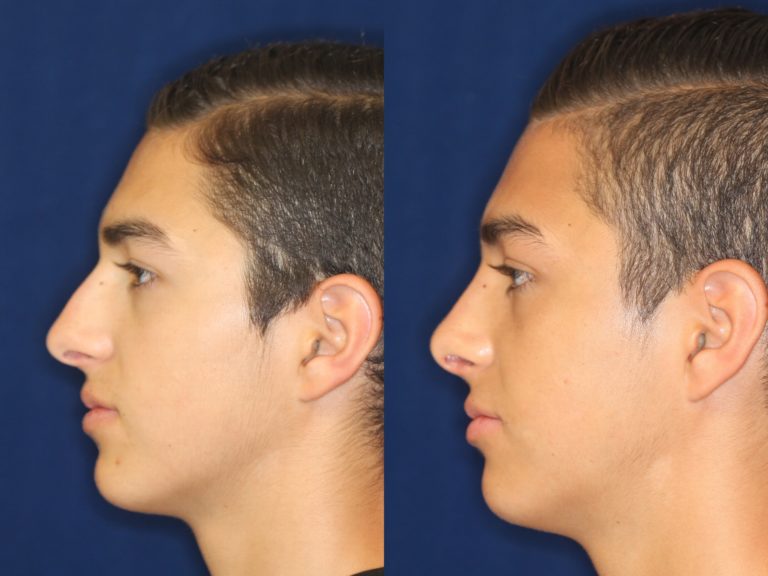
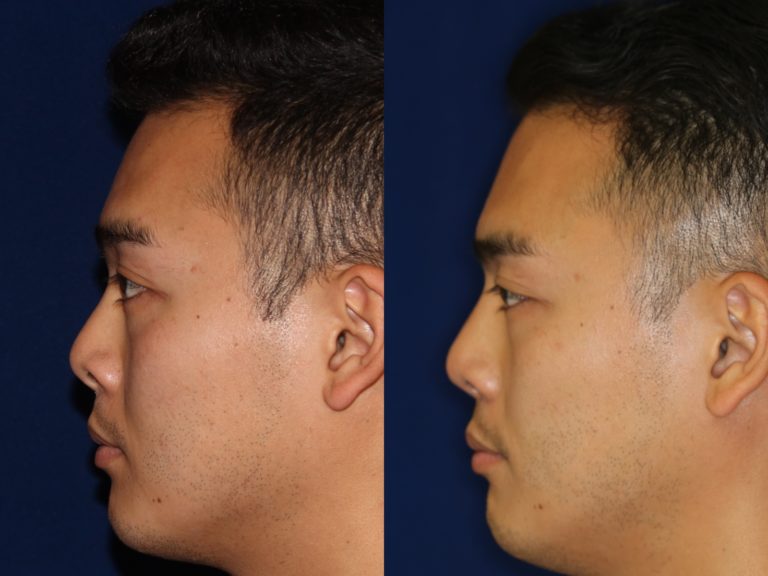
What is Ethnic Rhinoplasty?
Ethnic rhinoplasty in reality is appropriate rhinoplasty on the various members of our population who hail from assorted regions of the world. While most Americans’ ancestors came from Europe, the percentage of our citizens with that history is being diluted by those from throughout the globe. When there is intermarriage, that really gets interesting. In our practice in Beverly Hills, we see the fascinating mosaic of genetics!
Am I a Candidate for Ethnic Rhinoplasty?
Ethnic rhinoplasty is for any person looking to improve the look of their nose without reversing one’s attachment to their ethnic ancestry or trying to mimic socially admired Western facial features.
How Dr. Kotler Approaches Ethnic Rhinoplasty
Understanding the scope of your surgery and the adjustment necessary to create improved balance in facial features is of the utmost importance; not all imperfections or features can be corrected by surgeons, regardless of their talent, level of experience and degree of specialization. Dr. Kotler approaches his ethnic rhinoplasty consultations with a patient education mindset. It’s important to set the right expectations to create results that patients love.
Dr. Kotler believes in conservative and proven techniques when performing ethnic rhinoplasty; the key to a natural and a satisfactory result is ensuring just the right amount of tissue is removed. Over treatment is a common and unfortunate mistake in nose surgery. For Dr. Kotler and his ethnic nose job patients, the less-is-more philosophy proves to create the best possible cosmetic result.
At Dr. Kotler’s practice, every nose surgery is performed using the closed rhinoplasty technique, which is less invasive when comparing closed to open rhinoplasty. Be sure to ask if this treatment method will work for you or whether an open technique can best address your needs. The goal is to create the following: A bridge that is straight or has a very slight tilt towards the tip, but not too low. On the front view, the tip is not pinched, and the nostrils are not turned up.
Common Types of Ethnic Rhinoplasty
Each patient has distinct features, some more unusual than others. Nostril size and shape, skin thickness, cartilage strength are variable depending on one’s ethnicity. A sophisticated rhinoplasty surgeon knows not to deliver the same templated, standard-issue nose to all comers. For this reason there’s several types of ethnic rhinoplasty that a surgeon should have experience in: asian rhinoplasty, hispanic rhinoplasty, middle-eastern rhinoplasty, african american rhinoplasty, among others.
Asian Rhinoplasty
Surgical Rhinoplasty and Permanent Non-surgical Rhinoplasty are popular in Asia and wherever ethnic Asians reside. Southern California has a large population of Korean-Americans, in particular. Korean-Americans have distinct taste with respect to their concept of a satisfactory change to the nose. Their sense of a proper profile is distinct from other Asian ethnics, for example. Filipinos typically have wide nostril floors, thick alae or wings and flatter tips. Chinese and Japanese patients have their own particular tastes, also.
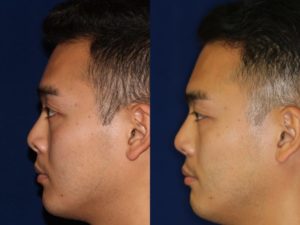
In Asian rhinoplasty, nostril narrowing may be required. While the thickness of the wings or alae, in medical terms, are thick, that cannot be corrected. What is corrected is the width of the floor or sill of the nostrils. A nifty procedure that helps narrow the lowest portion of the nose. The total width of the nose at cheek attachment is narrowed. The incisions are part internal and part external. The external incision is placed into the groove between the nostril wall and the lip. It is an ideal location to be inconspicuous. However, the surgeon must execute and close the incisions in the finest fashion lest they be visible or worse, thicken during healing. This can be corrected but best avoided by meticulous, painstaking closure of the incision.
It is extremely important for the rhinoplasty specialist to not deliver “one nose for all.” It is a ticket to a disappointed patient who might face a Revision Rhinoplasty or a Revision Permanent Non-surgical Rhinoplasty. The doctor must look, feel, think and study his patient. And, there is no better use for computer imaging to explore the practicalities and possibilities of change in share of the nose to provide improvement but not such a change as to render the end result looking strange, inappropriate or unnatural.
Whether the request is for a “nose lift” or a “higher bridge” or a “narrower tip” or “smaller nostrils,” all must be considered and then a frank discussion be had as to the wisdom of such a change and whether or not there are technical challenges in achieving. But only with computer imaging can an important and meaningful discussion take place. That is the requirement for a commitment by the surgeon and patient to move forward.
African American Rhinoplasty
African American facial features, including the nose, may represent a genetic blend of other races and ethnicity. We see African American patients whose father was Caucasian but the dominant gene expression is that of the African American mother. Likewise, there are patients who identify as black, but who have a black father and Asian mother.
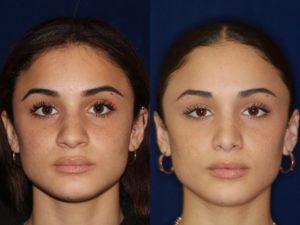
Very careful scrutiny and evaluation is necessary as the surgeon must take all genetic blends and genetic influence on tissue form and structure into account when performing an African American nose job. Interestingly, when evaluating a black patient with no known other genetic component, one sees certain features in other non-white ethnic groups, e.g. flat tip wide nostril base, thick wings. So, each of the definable parts of the nose may or may not share its characteristics with other ethnic groups.
African American rhinoplasty shares some of the same challenges as Asian Rhinoplasty. Typically, the skin is not as thick, but the nostril and wing anatomy can present a challenge.
Non-surgical Rhinoplasty comes in handy for this population just as it does for the Filipino, Korean, Cambodian and Thai population. The African American or Black American population has more variation in nasal structure. Some, have a very Caucasian structure. Their surgery calls for no special additional procedures.
As with all ethnic patients, computer imaging is essential to a meaningful and objective discussion of the outcome of the surgical or Permanent Non-surgical undertaking.
Persian, Middle Eastern, & Arabic Rhinoplasty
Many middle eastern families reside in Southern California so we perform procedures for many patients of this ethnicity. The “ Persian Nose” may have a large bump, a droopy tip, and sometimes soft cartilage.
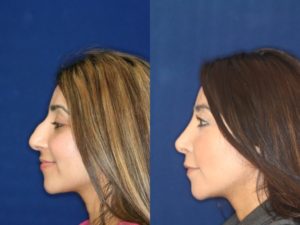
These features call for careful analysis at the consultation. Also, there is the concern that the nose looks natural. Many patients from the Middle East come to Dr. Kotler with reports that their surgeons overdid the nose. Their results may be too upturned, pinched and sport a low bridge. They might work on an Irish face but not on a nose with roots in the Levant. A middle eastern rhinoplasty must not be too short vertically, too scooped, too pinched and overall, too small for the face is less desirable.
Those who travel directly or by immigration from the Arabic states, such as Saudi Arabia, Kuwait, Qatar, et al may have particular nasal features. The bump or hump may be quite profound. The tip may be very plunging and too close to the upper lip. The tip may drastically depress with smiling giving the appearance, particularly in photos, of being super-long. These imperfections can all be managed. Again, think skin. Some of these nationalities have very dark skin and so the issue of an external incision, open rhinoplasty needs to be considered. Alternatively the patient can seek a closed rhinoplasty using internal incisions, the preferred technique used by Dr. Kotler, which will have hidden incisions and no scarring.
The Middle East is a great melting pot and so all bets are off with respect to commonality of skin color and texture, cartilage strength and thickness and shape of nostrils, wings, and height of bridge. For these patients, every ethnic rhinoplasty decision is “custom made.”
Hispanic & Latin Rhinoplasty
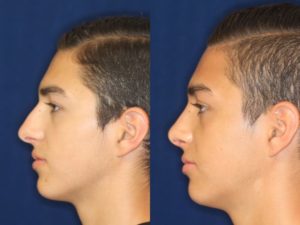 In the U.S. we refer to our citizens and guests whose origin is Central America as “Hispanic.” That territory, genetically and geographically, is huge and Dr. Kotler has performed hundreds of hispanic rhinoplasties. Mexicans are often very different in facial appearance from Colombians who dwell at the top of South America. Again, through genetical evolution and intermarriage, primarily with Europeans, all bets are off in regards to a “typical Hispanic.” Those from Mexico may have some high percentage of native Indian genetics with very dark skin which can pigment easily. And, the Mestizo nose has a flat, plunging tip. So we need to consider cartilage grafting or non-surgical, liquid rhinoplasty to augment the surgical work.
In the U.S. we refer to our citizens and guests whose origin is Central America as “Hispanic.” That territory, genetically and geographically, is huge and Dr. Kotler has performed hundreds of hispanic rhinoplasties. Mexicans are often very different in facial appearance from Colombians who dwell at the top of South America. Again, through genetical evolution and intermarriage, primarily with Europeans, all bets are off in regards to a “typical Hispanic.” Those from Mexico may have some high percentage of native Indian genetics with very dark skin which can pigment easily. And, the Mestizo nose has a flat, plunging tip. So we need to consider cartilage grafting or non-surgical, liquid rhinoplasty to augment the surgical work.
However, the well-trained and savvy surgeon knows what generic expressions to look for. For example, there is a subset of Central Americans who have nearly 100% indigenous lineage. Intermarriage with Spaniards and other Europeans and migrants from even Asia produces interesting nasal and facial structure. Some of the more native Central Americans have very wide bases of the nose, flat and poorly projecting tips, wide nostrils. Peruvians, tend to have very high bridges, and often with a bump.
Once again, the thoughtful surgeon asks questions of ancestry, carefully examines the facial and nasal structure and provides a realistic computer image rendering to demonstrate the achievable result of rhinoplasty or permanent non-surgical rhinoplasty.
Latin rhinoplasty is designated to identify those who may hail from Colombia, Argentina, and Brazil. Large variety of rhinoplasty opportunities there, but there is a huge variation in appearance. Many look very European, particularly the Argentinians, many of whom had/have Italian ancestors. Brazil is a melting pot. All skin tones, nasal and facial structures represented. It too, was settled by Europeans, predominantly those from Portugal. The challenge is unchanged: to customize the nose with the target of improvement and not a great variant that seems inconsistent with one’s ethnicity.
Diversity in Rhinoplasty: Speaking with Ethnic Rhinoplasty Patients About Their Procedure
The aim of every rhinoplasty, regardless of the ethnicity of the patient is to deliver a natural nose that matches the other facial features. That one sentence really states the mission. A surgeon experienced in rhinoplasty for the multitude of American ethnicities knows that the common fault in the performance by surgeons who are inadequately trained, under-experienced and not narrowly specialized is that they will deliver an “overdone” nose. And, that is the great fear of the ethnic rhinoplasty patient. The nose will present such a different change that it now overrides the other often-excellent facial features and focuses the viewers’ eyes on it. Not the way it should be. The nose should just blend into the face and looks like it belongs and match the other facial features.
Amateur, unsophisticated, under-specialized surgeons will typically turn out a nose that looks like the few others he has done. The superspecialist, the hyper-experienced surgeon, typically in our larger cities with the abundance of ethnicities, knows better and knows many different techniques to achieve the great result. He or she will do computer imaging for the patient and use it to plan the operation, similar to how an architect uses a blueprint.
A surgeon who cares for ethnic patients needs to pose three questions to himself/herself and the patient:
- What specific parts of the nose are unsatisfactory to the patient?
- Can those parts be changed without an unnatural appearance?
- Would the patient be satisfied with the changes the surgeon recommends?
Technically, every part of the nose can be changed. But should it be changed? And, can it be changed such that it blends with other parts of the nose and is satisfactory as one of the parts of the sum? This is where surgeon judgment, the most precious asset, exerts itself. The superior surgeon knows what can be done and should be done to produce a satisfactory, natural appearing nose.
The best way to evaluate a given surgeons’ talent and expertise in modifying ethnic noses is to see a large variety of examples of the surgeon’s work on the practice website’s photo gallery or in the office photo collection. If you see natural, “ethnically appropriate” results, you too are likely to be happy and satisfied.
What Are the Benefits of Ethnic Rhinoplasty?
The benefits are all to the patient. The ethnic patient’s desires are no different than those of the non-ethnic. The ethnic rhinoplasty patient just wants a better nose that fits the face. It’s that simple.
Ethnic Nasal Features Patients Often Correct
- Wide bridge
- Wide tip
- Flat or poorly defined tip
- Plunging tip that worsens with smile
- Low bridge
- Nose too close to upper lip
- Crookedness or asymmetry
- Blocked breathing in conjunction with crookedness or other external imperfection
- Wide nostril base
Recovery After an Ethnic Rhinoplasty Procedure
Rhinoplasty recovery for an ethnic nose job may take 7-10 days. All exercise can be resumed on day 10, except contact sports, obviously. Returning to work is a similar timeframe. When protective splints are removed on the fifth day after surgery, one can perceive the changed architecture. But, there is swelling which recedes constantly. People look “good” at 10-14 days, “great” at 30 days and “fantastic” thereafter. Over 90% of the result is in 100 days, the normal healing period for any operation on the body.
The surgeon should provide to the ethnic rhinoplasty patient a prescription-level pain medicine. For some, non-prescription painkillers such as Tylenol or Extra-strength Tylenol will suffice but pain is not predictable. You may want a strong medication to use. The good news is, it’s only for a few days. Your doctor can speak to you about:
- Pain medicines, including prescription drugs provided for the first five days.
- Anti-swelling, anti-bruising medications, e.g. Arnica, started day prior to surgery.
- Antibiotics to prevent infection
- Platelet-rich Plasma placed within the nasal chamber to reduce swelling and bruising and hasten healing.
Regular diet begins the next day for Ethnic Rhinoplasty patients.
After Ethnic Rhinoplasty, as with all cosmetic surgeries, no strenuous exercise for ten days. After ten days, full workout should be fine if there have been no complications. The need to hold back on immediately resuming strenuous exercise is that high-intensity exercise raises blood pressure. Elevated blood pressure is the enemy of healing because of the propensity for bleeding and then more swelling and bruising.
Walking is a great post-ethnic rhinoplasty exercise. Helps the circulation flush out the anesthetics and the increased circulation accelerates the resolution of swelling and bruising.
Followup appointments depend on the nature of the procedure(s) performed. Typically, if one has had only the cosmetic procedure, the Kotler Nasal Airway placed for breathing and the internal nasal packing placed to prevent serious bleeding, reduce infection and speed healing are removed the day after surgery in the office. Those patients who have functional surgery either with cosmetic surgery or independently whereby it is necessary to operate on the internal nasal septum and turbinates, the packing and air tube are left in for four days. On that fourth postop day whether one has had the functional surgery with or without rhinoplasty, or if one has had only rhinoplasty, the external plastic protector is removed. Therefore, by the fourth day after surgery everything is out, and everything is off.
The next visit typically is one to two weeks after surgery. Thereafter, once a month, for the first three months total. Generally at the 100th day, healing is considered complete and even though there is some minor further refinement at the one year mark, the final result is in. It is interesting to note that this is a consistent milestone after all surgical procedures roughly three months or 100 days.
After seven to ten days, most patients feel fine and their appearance is satisfactory to return to work. If the reconstructive/ breathing procedures were also done, on the long end, two weeks.
Key Components to Successful Surgery
Skin thickness and color, as well as the consistency of the cartilage and the bone, are often reflective of one’s ancestry; there is a major difference between the thin, light-colored skin of a person with English, Scottish, or Finnish background, versus the thicker and more pigmented tissue of someone whose family hails from Southern Italy or the Middle East. Some people, particularly those who are of Asian and Hispanic descent, tend to have softer cartilages. But the unique components of ethnic rhinoplasty don’t stop here. As a superspecialist in rhinoplasty, Dr. Kotler recognizes that your procedure should also take the following into account:
- Less is more – Dr. Kotler believes in conservative and proven techniques when performing ethnic rhinoplasty.” Overdone” is far worse than “ underdone”, since the overdone nose is easy to spot because it is not in sync with the ethnicity and does not blend well with the other facial features. Nothing looks worse that an short, turned up Irish nose sitting on the face of a patient from the Middle East.
- Closed Rhinoplasty is the best technique for ethnic rhinoplasty – Nearly all nasal surgeries are performed using the closed rhinoplasty technique. All incisions are hidden within the nasal interior and all stitches dissolve. For those ethnic patients with dark or olive skin, avoiding a visible, external incision up front, connecting the nostrils is important since there is some potential for visibility and skin discoloration, particularly.
- Study before and after photos – The best evidence of a rhinoplasty surgeon who “gets it” regarding ethnic rhinoplasty is the doctors’ before and after photo gallery. If the noses look appropriate, natural and consistent with the ethnicity, you are witnessing the talent you want.
Ethnic Rhinoplasty Cost
The cost of an ethnic rhinoplasty is related to the complexity and time to perform. Since cartilage grafting may be needed, there is a reflection in rhinoplasty pricing. Often, augmenting the surgical result with post-operative filler or liquid rhinoplasty will help achieve the great result. That service will be included in the fee.
Ethnic Rhinoplasty FAQ
Ethnic rhinoplasty is best performed by the specialized rhinoplasty surgeon that understands and has proven experience working with features that apply to a particular ethnic group. There are more factors to consider than a traditional rhinoplasty. Not only may the nose be unique to the ethnicity but other features such as the lips, eyes, cheekbones. The nasal cartilage stiffness and skin texture and thickness varies greatly among ethnic groups and even within a given ethnic group. Nostrils may be more oblique or vertical. The floor or sill of the nostrils may be wide and the ala or wings may be very thick and tall. The bridge may be very low or very high. There are many parts involved in the procedure for the surgeon to consider. The level of detail required of an ethnic nose job requires the skills of a seasoned rhinoplasty surgeon with years of experience performing an ethnic rhinoplasty procedure.
Ethnic rhinoplasty implies a greater talent in delivering a natural rhinoplasty result for a patient whose nose is different than the great majority of patients who are white-skinned, of European stock, e.g., England, Scotland, France, Germany, Poland, the Baltic nations, Russia, and the Scandinavian Countries. Different facial features, skin type and fairly consistent. Often, it is impossible to tell the country of origin.
Any rhinoplasty, ethnic or “otherwise”, can be accompanied by certain other cosmetic surgeries. Other facial procedures such as eyelid, chin, neck or face lift. Body procedures, e.g., liposuction, breast augmentation or reduction, tummy tuck. May require two or three different specialist surgeons but depending on length of procedures, usually makes time and economic sense. The recovery periods overlap.
Surgical risks, lower than ever are, as with any operation, infections, bleeding, scarring. We prefer the closed or internal rhinoplasty since there are no external incisions that might be visible or develop unsightly scars.
The risks of surgery and/or anesthesia are not different for ethnic patients. Obviously, since some hereditary diseases such as Sickle Cell Anemia, which resides in specific ethnic populations, a full medical evaluation should proceed the commitment to perform surgery.
There’s no difference in the lifespan of ethnic rhinoplasty. Results will last you a lifetime. Our patients check in 15+ years later, and continue to be just as happy with the outcome of their ethnic rhinoplasty procedure.
While facial surgeons may have the board-certification and other credentials, only he or she knows if performing ethnic rhinoplasty—successfully – is within their talent sphere. Wise questioning by the prospective patient will determine that. The best question: “May I see several befores and afters of patients of my ethnicity?”
Yes. But only those placed on the outside. Open Rhinoplasty requires such external, visible incisions. There are office treatments to correct keloid scars if they should occur.
The closed rhinoplasty has hidden, which make up the majority of Dr. Kotler’s patients, require internal incisions which themselves, are not visible and do not tend to scar as the external incisions may.
For some patients, satisfaction can often be provided with a Permanent Non-surgical Rhinoplasty procedure. For them, a trip to the operating room may be avoided entirely.

